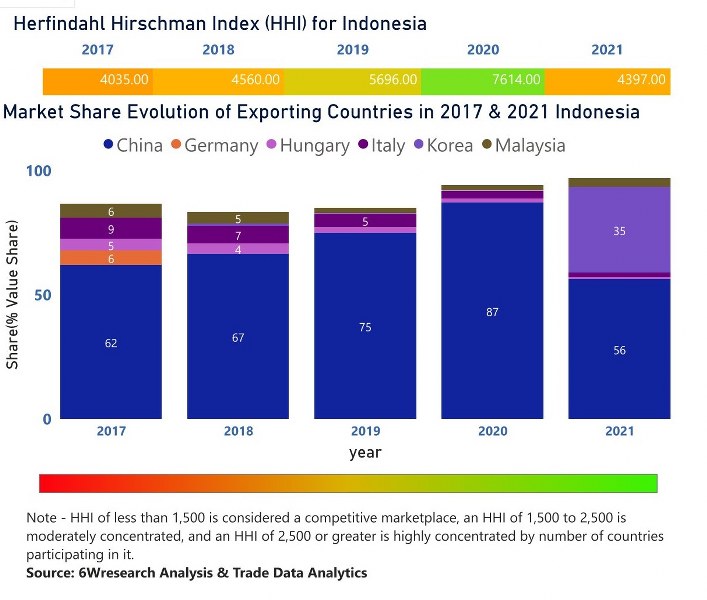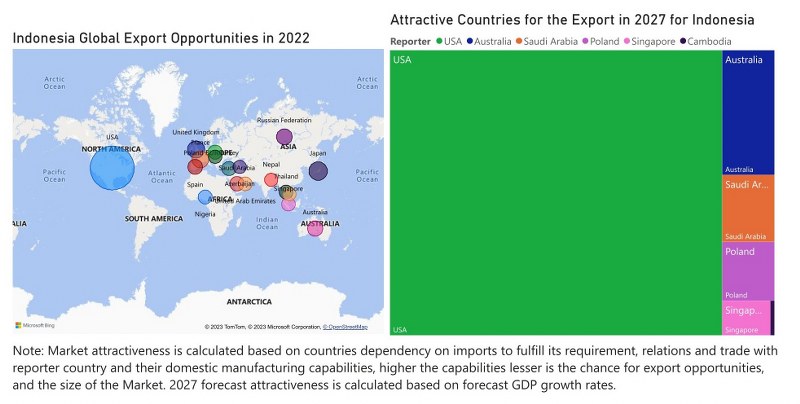Indonesia Vacuum Cleaners Market (2020-2026) | Share, Trends, Growth, Revenue, Forecast, Analysis, value, industry, Outlook & COVID-19 IMPACT
Market Forecast By Products (Canister, Robotics, Upright & Others),By Distribution Channel (Online, Offline),By End Users (Industrial, Commercial, Residential), and Competitive Landscape
| Product Code: ETC004461 | Publication Date: Sep 2022 | Updated Date: Aug 2025 | Product Type: Report | |
| Publisher: 6Wresearch | Author: Ravi Bhandari | No. of Pages: 70 | No. of Figures: 35 | No. of Tables: 5 |
Indonesia Vacuum Cleaners Market | Country-Wise Share and Competition Analysis
In the year 2021, China was the largest exporter in terms of value, followed by Rep. of Korea. It has registered a growth of 40.1% over the previous year. While Rep. of Korea registered a growth of 68134.12% as compared to the previous year. In the year 2017, China was the largest exporter followed by Italy. In terms of the Herfindahl Index, which measures the competitiveness of countries exporting, Indonesia has a Herfindahl index of 4035 in 2017 which signifies high concentration also in 2021 it registered a Herfindahl index of 4397 which signifies high concentration in the market.
![]() Indonesia Vacuum Cleaners Market - Export Market Opportunities
Indonesia Vacuum Cleaners Market - Export Market Opportunities
![]() Latest (2023) Development of the Indonesia Vacuum Cleaners Market
Latest (2023) Development of the Indonesia Vacuum Cleaners Market
Indonesia Vacuum Cleaners Market is likely to grow in the forthcoming years. The rise in disposable income among individuals and households and increasing awareness of hygiene and cleanliness are leading to the growth of the market. Due to the rise in technology, producers are now focusing on manufacturing the latest products to cater to the various needs of consumers. Robotic vacuum cleaners are also contributing to the growth of the market. Manufacturers are looking for various ways to produce eco-friendly and sustainable products. There is a tremendous growth of the e-commerce platforms in the country and this has made it easier for the customers to buy these products online from the comfort of their homes. The future of the market is bright due to major innovations in technology and a major shift of consumers towards sustainable brands in the market.
Topics Covered In the Indonesia Vacuum Cleaners Market Report
The Indonesia Vacuum Cleaners Market report thoroughly covers the market by product, distribution channel, and end users. The market outlook report provides an unbiased and detailed analysis of the ongoing market trends, opportunities/high growth areas, and market drivers which would help the stakeholders to devise and align their market strategies according to the current and future market dynamics.
Indonesia Vacuum Cleaners Market Synopsis
Indonesia Vacuum Cleaners Market is anticipated to grow in the forecast period due to the high demand for modern and efficient household appliances in the country. Rapid urbanization is one of the major factors for the immense development of the market.
According to 6Wresearch, the Indonesia Vacuum Cleaners Market size is expected to register growth during 2020-2026. The market is expected to gain momentum during the upcoming years owing to increasing disposable income and the busy lifestyle of the people. Rising purchasing power along with less time for household chores is adding to the development of the market. The growing hospitality and healthcare sector coupled with increasing penetration towards health and hygiene is bolstering the growth of the industry. Moreover, the increasing benefits associated with the usage of vacuum cleaners such as ease of cleaning under a bed is providing lucrative opportunities for the development of the industry. The intense competition from the various brands has significantly led to a decline in Indonesia Vacuum Cleaners Market Growth. Changing consumer preferences have also impacted the market as consumers are now opting for cordless stick vacuums that offer more convenience and ease of use. Another major obstacle for the market is the high cost of production and distribution
COVID-19 Impact on Indonesia Vacuum Cleaners Market
Indonesia Vacuum Cleaners Industry was significantly impacted by the sudden outbreak of the pandemic as it changed the various dimensions of the industry. There was a surge in demand for vacuum cleaners on account of people spending more time at their homes. The increased demand posed a challenge for the manufacturers as they faced numerous difficulties in meeting up the heavy demand by the consumers. The shutdown of factories and restrictions on transportation and movement led to delays in delivery of the product. The pandemic also brought financial hardships and it led to a decline in the demand for the cleaning equipment as the consumers were unwilling to invest in non-essential items. The market is an integral part of the Asia Pacific (APAC) Vacuum Cleaners Market and these factors have adversely impacted the market.
Future of the Indonesia Vacuum Cleaners Market
The future of the Vacuum Cleaners Market in Indonesia is predicted to be positive. An increasing number of households in the country and consumer demand for efficient cleaning solutions have led to the extensive growth of the market. Robotic vacuum cleaners are gaining immense popularity and this is further driving the growth in this sector. The changing lifestyles of the population, increasing disposable incomes, and numerous government initiatives have widened the scope of development in the years to come.
Market by Product
On the basis of products, the canister vacuum cleaner segment is expected to witness major growth in the market as it provides strong suction power for efficient cleaning.
Market by Distribution Channel
According to Ravi Bhandari, Research Head, 6Wresearch, the online segment will significantly witness growth as it provides users ease and convenience and numerous options to choose from.
Market by End Users
On the basis of end users, the market is divided into industrial, commercial, and residential. The residential segment is projected to grow due to immense growth in the population and it has led to a major rise in the Indonesia Vacuum Cleaners Market Share.
Key players in the market
Some of the major players operating in the Indonesia Vacuum Cleaners Market globally are:
- Alfred Karcher SE & Co. KG
- BISSELL Inc.,
- CRAFTSMAN
- DEWALT
- Dyson
- ECOVACS
- Emerson Electric Co.
- Haier Group
- iRobot Corporation
- Neato Robotics, Inc.
- Nilfisk Group
- Panasonic Holdings Corporation
- Snow Joe LLC
Key Attractiveness of the Report
- COVID-19 Impact on the Market.
- 10 Years Market Numbers.
- Historical Data Starting from 2016 to 2019.
- Base Year: 2019.
- Forecast Data until 2026.
- Key Performance Indicators Impacting the Market.
- Major Upcoming Developments and Projects.
Key Highlights of the Report:
- Indonesia Vacuum Cleaners Market Overview
- Indonesia Vacuum Cleaners Market Outlook
- Indonesia Vacuum Cleaners Market Forecast
- Historical Data of Indonesia Vacuum Cleaners Market Revenues & Volume for the Period 2016-2019
- Indonesia Vacuum Cleaners Market Size and Indonesia Vacuum Cleaners Market Forecast of Revenues & Volume, Until 2026
- Historical Data of Indonesia Vacuum Cleaners Market Revenues & Volume, by Products, for the Period 2016-2019
- Market Size & Forecast of Indonesia Vacuum Cleaners Market Revenues & Volume, by Products, Until 2026
- Historical Data of Indonesia Vacuum Cleaners Market Revenues, by Distribution Channel, for the Period 2016-2019
- Market Size & Forecast of Indonesia Vacuum Cleaners Market Revenues, by Distribution Channel, Until 2026
- Historical Data of Indonesia Vacuum Cleaners Market Revenues, by End Users, for the Period 2016-2019
- Market Size & Forecast of Indonesia Vacuum Cleaners Market Revenues, by End Users, Until 2026
- Historical Data of Central Region Vacuum Cleaners Market Revenues, for the Period 2016-2019
- Market Size & Forecast of Central Region Vacuum Cleaners Market Revenues, Until 2026
- Historical Data of Western Region Vacuum Cleaners Market Revenues, for the Period 2016-2019
- Market Size & Forecast of Western Region Vacuum Cleaners Market Revenues, Until 2026
- Historical Data of Southern Region Vacuum Cleaners Market Revenues, for the Period 2016-2019
- Market Size & Forecast of Southern Region Vacuum Cleaners Market Revenues, Until 2026
- Historical Data of Eastern Region Vacuum Cleaners Market Revenues, for the Period 2016-2019
- Market Size & Forecast of Eastern Region Vacuum Cleaners Market Revenues, Until 2026
- Market Drivers and Restraints
- Indonesia Vacuum Cleaners Market Trends and Industry Life Cycle
- Porter’s Five Force Analysis
- Market Opportunity Assessment
- Indonesia Vacuum Cleaners Market Share, By Players
- Indonesia Vacuum Cleaners Market Share, By Regions
- Indonesia Vacuum Cleaners Market Overview on Competitive Benchmarking
- Company Profiles
- Key Strategic Recommendations
Market Covered
The report offers a comprehensive study of the subsequent market segments:
By Product
- Canister
- Robotics
- Upright
- Others
By distribution channel
- Online
- Offline
By End Users
- Industrial
- Commercial
- Residential
Indonesia Vacuum Cleaners Market: FAQs
| 1. Executive Summary |
| 2. Introduction |
| 2.1 Report Description |
| 2.2 Key Highlights of The Report |
| 2.3 Market Scope & Segmentation |
| 2.4 Research Methodology |
| 2.5 Assumptions |
| 3. Indonesia Vacuum Cleaners Market Overview |
| 3.1 Indonesia Country Indicators |
| 3.2 Indonesia Vacuum Cleaners Market Revenues and Volume 2016-2026F |
| 3.3 Indonesia Vacuum Cleaners Market Revenue Share, By Products, 2019 & 2026F |
| 3.4 Indonesia Vacuum Cleaners Market Revenue Share, By Distribution Channel, 2019 & 2026F |
| 3.5 Indonesia Vacuum Cleaners Market Revenue Share, By End User, 2019 & 2026F |
| 3.6 Indonesia Vacuum Cleaners Market Revenue Share, By Regions, 2019 & 2026F |
| 3.7 Indonesia Vacuum Cleaners Market - Industry Life Cycle |
| 3.8 Indonesia Vacuum Cleaners Market - Porter’s Five Forces |
| 4. Indonesia Vacuum Cleaners Market Dynamics |
| 4.1 Impact Analysis |
| 4.2 Market Drivers |
| 4.2.1 Increasing awareness about cleanliness and hygiene in households |
| 4.2.2 Rising disposable income leading to higher spending on household appliances |
| 4.2.3 Growing urbanization and modernization in Indonesia |
| 4.3 Market Restraints |
| 4.3.1 High initial cost of purchasing vacuum cleaners |
| 4.3.2 Limited availability of advanced vacuum cleaner models in remote areas |
| 4.3.3 Lack of proper infrastructure for after-sales services and repairs |
| 5. Indonesia Vacuum Cleaners Market Trends |
| 6. Indonesia Vacuum Cleaners Market Overview, By Products |
| 6.1 Indonesia Vacuum Cleaners Market Revenues and Volume, By Canister, 2016-2026F |
| 6.2 Indonesia Vacuum Cleaners Market Revenues and Volume, By Upright, 2016-2026F |
| 6.3 Indonesia Vacuum Cleaners Market Revenues and Volume, By Robotics, 2016-2026F |
| 6.4 Indonesia Vacuum Cleaners Market Revenues and Volume, By Others, 2016-2026F |
| 7. Indonesia Vacuum Cleaners Market Overview, By Distribution Channel |
| 7.1 Indonesia Vacuum Cleaners Market Revenues and Volume, By Online, 2016-2026F |
| 7.2 Indonesia Vacuum Cleaners Market Revenues and Volume, By Offline, 2016-2026F |
| 8. Indonesia Vacuum Cleaners Market Overview, By End User |
| 8.1 Indonesia Vacuum Cleaners Market Revenues and Volume, By Industrial, 2016-2026F |
| 8.2 Indonesia Vacuum Cleaners Market Revenues and Volume, By Commercial, 2016-2026F |
| 8.3 Indonesia Vacuum Cleaners Market Revenues and Volume, By Residential, 2016-2026F |
| 9. Indonesia Vacuum Cleaners Market - Key Performance Indicators |
| 10. Indonesia Vacuum Cleaners Market - Opportunity Assessment |
| 10.1 Indonesia Vacuum Cleaners Market Opportunity Assessment, By Products, 2026F |
| 10.2 Indonesia Vacuum Cleaners Market Opportunity Assessment, By Distribution Channel, 2026F |
| 10.3 Indonesia Vacuum Cleaners Market Opportunity Assessment, By End User, 2026F |
| 11. Indonesia Vacuum Cleaners Market Competitive Landscape |
| 11.1 Indonesia Vacuum Cleaners Market Revenue Share, By Company |
| 11.2 Indonesia Vacuum Cleaners Market Competitive Benchmarking, By Operating & Technical Parameters |
| 12. Company Profiles |
| 13. Key Recommendations |
| 14. Disclaimer |
- Single User License$ 1,995
- Department License$ 2,400
- Site License$ 3,120
- Global License$ 3,795
Search
Related Reports
- Vietnam System Integrator Market (2025-2031) | Size, Companies, Analysis, Industry, Value, Forecast, Growth, Trends, Revenue & Share
- ASEAN and Thailand Brain Health Supplements Market (2025-2031) | Strategy, Consumer Insights, Analysis, Investment Trends, Opportunities, Growth, Size, Share, Industry, Revenue, Segments, Value, Segmentation, Supply, Forecast, Restraints, Outlook, Competition, Drivers, Trends, Demand, Pricing Analysis, Competitive, Strategic Insights, Companies, Challenges
- ASEAN Bearings Market (2025-2031) | Strategy, Consumer Insights, Analysis, Investment Trends, Opportunities, Growth, Size, Share, Industry, Revenue, Segments, Value, Segmentation, Supply, Forecast, Restraints, Outlook, Competition, Drivers, Trends, Demand, Pricing Analysis, Competitive, Strategic Insights, Companies, Challenges
- Europe Flooring Market (2025-2031) | Outlook, Share, Industry, Trends, Forecast, Companies, Revenue, Size, Analysis, Growth & Value
- Saudi Arabia Manlift Market (2025-2031) | Outlook, Size, Growth, Trends, Companies, Industry, Revenue, Value, Share, Forecast & Analysis
- Uganda Excavator, Crane, and Wheel Loaders Market (2025-2031) | Strategy, Consumer Insights, Analysis, Investment Trends, Opportunities, Growth, Size, Share, Industry, Revenue, Segments, Value, Segmentation, Supply, Forecast, Restraints, Outlook, Competition, Drivers, Trends, Demand, Pricing Analysis, Competitive, Strategic Insights, Companies, Challenges
- Rwanda Excavator, Crane, and Wheel Loaders Market (2025-2031) | Strategy, Consumer Insights, Analysis, Investment Trends, Opportunities, Growth, Size, Share, Industry, Revenue, Segments, Value, Segmentation, Supply, Forecast, Restraints, Outlook, Competition, Drivers, Trends, Demand, Pricing Analysis, Competitive, Strategic Insights, Companies, Challenges
- Kenya Excavator, Crane, and Wheel Loaders Market (2025-2031) | Strategy, Consumer Insights, Analysis, Investment Trends, Opportunities, Growth, Size, Share, Industry, Revenue, Segments, Value, Segmentation, Supply, Forecast, Restraints, Outlook, Competition, Drivers, Trends, Demand, Pricing Analysis, Competitive, Strategic Insights, Companies, Challenges
- Angola Excavator, Crane, and Wheel Loaders Market (2025-2031) | Strategy, Consumer Insights, Analysis, Investment Trends, Opportunities, Growth, Size, Share, Industry, Revenue, Segments, Value, Segmentation, Supply, Forecast, Restraints, Outlook, Competition, Drivers, Trends, Demand, Pricing Analysis, Competitive, Strategic Insights, Companies, Challenges
- Israel Intelligent Transport System Market (2025-2031) | Strategy, Consumer Insights, Analysis, Investment Trends, Opportunities, Growth, Size, Share, Industry, Revenue, Segments, Value, Segmentation, Supply, Forecast, Restraints, Outlook, Competition, Drivers, Trends, Demand, Pricing Analysis, Competitive, Strategic Insights, Companies, Challenges
Industry Events and Analyst Meet
Our Clients
Whitepaper
- Middle East & Africa Commercial Security Market Click here to view more.
- Middle East & Africa Fire Safety Systems & Equipment Market Click here to view more.
- GCC Drone Market Click here to view more.
- Middle East Lighting Fixture Market Click here to view more.
- GCC Physical & Perimeter Security Market Click here to view more.
6WResearch In News
- Doha a strategic location for EV manufacturing hub: IPA Qatar
- Demand for luxury TVs surging in the GCC, says Samsung
- Empowering Growth: The Thriving Journey of Bangladesh’s Cable Industry
- Demand for luxury TVs surging in the GCC, says Samsung
- Video call with a traditional healer? Once unthinkable, it’s now common in South Africa
- Intelligent Buildings To Smooth GCC’s Path To Net Zero















